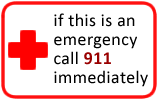Head Injury
Head Injury
Does this describe your child's symptoms? |
Click image for more info |
Definition
Types of Head Injuries
|
When to Call Your Doctor |
Call 911 Now (your child may need an ambulance) If |
|
|
|
Call Your Doctor Now (night or day) If |
|
|
|
Call Your Doctor Within 24 Hours (between 9 am and 4 pm) If |
|
|
|
Call Your Doctor During Weekday Office Hours If |
|
|
|
Parent Care at Home If |
|
|
HOME CARE ADVICE FOR SCALP INJURIES |
Wound Care: If there is a scrape or cut, wash it off with soap and water.Then apply pressure with a sterile gauze for 10 minutes to stop any bleeding.
Local Cold:
Apply a cold pack or ice bag wrapped in a wet cloth to any swelling for 20 minutes.
Reason: Prevent big lumps ("goose eggs"). Also, reduces pain.
Repeat in 1 hour, then as needed.
Observation: Observe your child closely during the first 2 hours following the injury.
Encourage your child to lie down and rest until all symptoms have cleared. (Note: mild headache, mild dizziness and nausea are common)
Allow your child to sleep if he wants to, but keep him nearby.
Awaken after 2 hours of sleeping to check the ability to walk and talk.
Diet: Offer only clear fluids to drink, in case he vomits. Regular diet OK after 2 hours.
Pain:
For pain relief, give acetaminophen every 4 hours OR ibuprofen every 6 hours as needed. (See Dosage Table)
Exception: avoid until 2 hours have passed from injury without any vomiting.
Never give aspirin to children and teens (Reason: always increases risk of bleeding).
Special Precautions at Night:
Mainly, sleep in same room as your child for 2 nights.
Reason: If a complication occurs, you will recognize it because your child will first develop a severe headache, vomiting, confusion or other change in their behavior.
Optional: if you are worried, awaken your child once during the night. Check the ability to walk and talk.
After 48 hours, return to a normal routine.
Expected Course: Most head impact only causes a scalp injury. The swelling may take a week to resolve. The local headache at the site of impact usually clears in 2 to 3 days.
Call Your Doctor If:
Pain or crying becomes severe
Vomiting occurs 2 or more times
Your child becomes difficult to awaken or confused
Walking or talking becomes difficult
Your child becomes worse
And remember, contact your doctor if your child develops any of the "Call Your Doctor" symptoms.
Updated:
March 22, 2017






